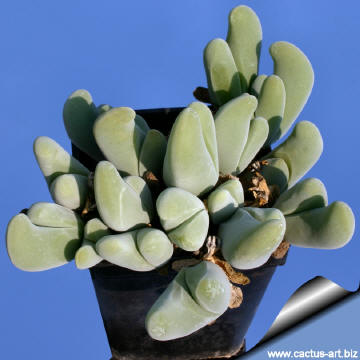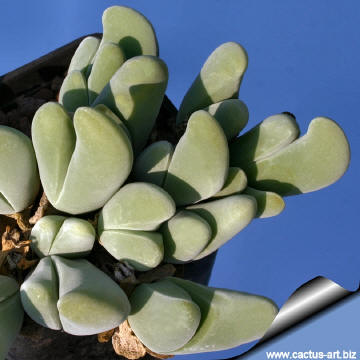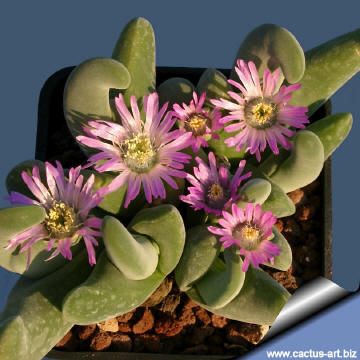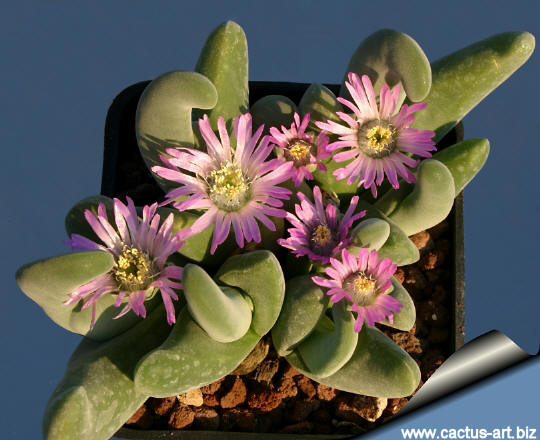|
|
|

Gibbaeum schwantesii Phisantefontein.
The flowers can be white or pink/violet, they open in winter
and last for a long time.
|
 |
 |
|
. |
 |
 |
|
. |
 |
 |
|
Advertising
|
|
|
|
|
Family: Mesebrianthemaceae (Aizoaceae)
Scientific name: Gibbaeum
schwantesii Tischer
1937
Origin: Riversdale, Little Karoo desert in South Africa
Habitat: Grows in flat areas
among white quartzite pebbles.
Synonyms:
- Mentocalyx muirii
N.E.Br.
In CG 1927:352.
- Gibbaeum muirii
Schwantes
in Jacobsen 1935: 180 Nomen illeg. Non N.E.Br. T.
Muir 3892 (K)A
Etymology:
The genus name "Gibbaeum"
is derived from the Latin word "gibba" which
means "hump" got its name from the leaf pair where the leaves
differ from each other in shape and size.
The name 'schwantesii' comes from Gustav Schwantes
(1881-1960), German professor of prehistory at Kiel University, and
Mesemb specialist. (Aizoaceae)
Various species of the genus Gibbaeum
are called in Afrikaans, ‘Haaibekkie’. In English this means ‘beak of
a shark’. This very apt name is derived from the shape of the two
leaves that together form the plant growth. They differ in size and
because these leaves grow closely together the fissure of most species
looks exactly like the beak of a shark, though without the teeth of
course.
|
|
Description: Perennial clumping,
mat forming succulents. Up to 5 cm tall and 10 (or more) cm wide. The
plant is compact with only the upper surface of leaves visible.
Leaves: Fleshy, dark green to green-brown or silvery/grey. The
leaves forms unequal pairs, in which the longer leaf is mostly
hook-shaped while the short one addpressed to it with a neat cut margin
visible close to the the longer leaf. The epidermis is covered by
characteristic minuscule branching hairs that give it a silver/velvety
appearance. Every year a few new leaves grow from the central stem.
Flowers: Daisy-like, white to pale pink/violet up to 2-5 cm in
diameter and long lasting. Pedicel 40-50 mm long. Petals white or white
apically suffused in pink, filamentous staminodes white, basally faintly
pink, filaments white
Blooming season: Winter.
Note: It must be distinguished
from the similar G. velutinum for its slender leaves, the
longer more strongly incurved than the shorter, the branching epidermal
hairs and the white or pinkish petals.
|
|
|
|

A
10 years old seedling.
Although this slow growing species has very small heads, it spreads into
grey-green carpets.
Cultivation:
Gibbaeums are "winter" growers heading for summer dormancy and
notoriously difficult to grow because they rot very easily, but G. shwantesii is not difficult at all in cultivation, keeps going over the
summer too and don’t’ need particular care . Requires little water
otherwise its epidermis breaks (resulting in unsightly scars). Water
minimally in summer, only when the plant starts shrivelling, water more
abundantly when they are growing in the fall and spring. Requires good
drainage. Keep cool and shaded in summer, need full sun or light shade.
They will take a light frost (Hardy to -5°C) if they are in dry soil.
Propagation: Seeds, cuttings |
|

 |
|